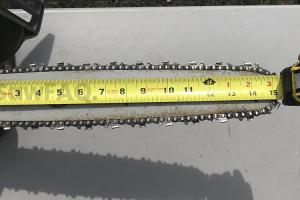Complete Guide to Measuring Chainsaw Bar Length: Tips & Techniques

-
Quick Links:
- Introduction
- Understanding Chainsaw Bars
- Why Chainsaw Bar Length Matters
- How to Measure Chainsaw Bar Length
- Tools You Need
- Step-by-Step Guide
- Common Mistakes to Avoid
- Case Studies and Expert Insights
- Maintaining Your Chainsaw Bar
- FAQs
Introduction
Chainsaws are indispensable tools for various tasks, from cutting firewood to clearing fallen branches after a storm. However, one of the most critical aspects of using a chainsaw effectively is understanding its components, particularly the bar length. In this guide, we will delve into the importance of measuring chainsaw bar length, the tools required, and a detailed step-by-step process to do so accurately.Understanding Chainsaw Bars
Chainsaw bars are the long, metal blades that hold the chain in place. They come in various lengths, which can significantly impact the performance and capabilities of the chainsaw. Generally, chainsaw bar lengths range from 10 inches to 36 inches or more.Types of Chainsaw Bars
- **Standard Bars**: Used for most cutting tasks. - **Reduced Kickback Bars**: Designed for safety, reducing the risk of kickback. - **Guide Bars**: Support the chain and direct its movement. Understanding the type of bar you have is essential when measuring its length, as each type may have specific measurement guidelines.Why Chainsaw Bar Length Matters
The length of the chainsaw bar affects the tool's cutting efficiency, maneuverability, and safety. A bar that is too long for the job can lead to inefficiencies and increased risk of accidents. Conversely, a bar that is too short may not be able to handle larger logs or trees effectively.Performance Considerations
- **Cutting Speed**: Longer bars allow for faster cuts through larger wood. - **Control**: Shorter bars provide better control for intricate cuts. Understanding these dynamics helps users select the right bar length for their tasks.How to Measure Chainsaw Bar Length
Measuring the chainsaw bar length is a straightforward process, but accuracy is crucial. Here's how to do it:Step 1: Safety First
Before you begin, ensure the chainsaw is turned off and unplugged (if electric). Wear safety gloves and goggles.Step 2: Locate the Measurement Point
The bar length is measured from the tip of the bar to the point where it enters the chainsaw body.Step 3: Use a Measuring Tape
- Take a measuring tape and align it with the tip of the bar. - Pull the tape down to the point where it meets the chainsaw body. - Record the length in inches.Tools You Need
To measure chainsaw bar length accurately, you will need: - A measuring tape (preferably one that is flexible). - A notepad and pen for jotting down measurements. - Safety gloves and goggles.Step-by-Step Guide
Let's break this down further into actionable steps: 1. **Prepare the Chainsaw**: Ensure the chainsaw is off and safely positioned. 2. **Measure the Bar**: Follow the steps outlined in the previous section. 3. **Double-Check Your Measurements**: Always measure twice to ensure accuracy. 4. **Compare with Manufacturer Specifications**: Refer to your chainsaw’s manual for the recommended bar length.Common Mistakes to Avoid
- Measuring from the wrong point on the bar. - Not accounting for any attachments or accessories on the bar. - Failing to use a flexible measuring tape, which can provide a more precise measurement.Case Studies and Expert Insights
In this section, we will share insights from professional arborists and experienced woodworkers about the importance of chainsaw bar length in their work. **Case Study 1**: John, a professional lumberjack, emphasizes that using a longer bar allows him to save time on larger jobs but also requires more skill to handle safely. **Expert Insight**: According to Dr. Alice Thompson, an expert in forestry, “Understanding the appropriate chainsaw bar length can lead to significant safety improvements and efficiency in wood cutting tasks.”Maintaining Your Chainsaw Bar
Proper maintenance of your chainsaw bar can extend its lifespan and enhance performance. Here are some tips: - Regularly clean the bar after use. - Apply bar oil to keep it lubricated. - Inspect for wear and tear, replacing it if necessary.FAQs
1. How do I know what size bar my chainsaw needs?
The size is usually indicated in the manufacturer’s manual, but you can measure it as described above.2. Can I use a longer bar on my chainsaw?
It depends on the chainsaw model; check the manufacturer’s specifications.3. What happens if I use the wrong bar length?
Using the wrong length can lead to inefficiencies, increased wear, and potentially dangerous situations.4. How often should I replace my chainsaw bar?
Replace it when you notice significant wear, bending, or damage.5. What is the best chainsaw bar length for beginners?
A bar length between 14 to 16 inches is typically recommended for beginners.6. How can I tell if my chainsaw bar is worn out?
Look for signs of bending, cracks, or excessive wear on the edges.7. Is bar length the same as chain length?
No, bar length refers to the length of the metal blade, while chain length refers to the total length of the chain that wraps around the bar.8. Can I measure my chainsaw bar length with a ruler?
While a ruler can work, a flexible measuring tape is more accurate.9. Do different chainsaw brands have different bar lengths?
Yes, different brands may have unique specifications for bar lengths.10. How does bar length affect cutting performance?
Longer bars can cut larger logs faster, whereas shorter bars offer greater control for detailed work.Random Reads